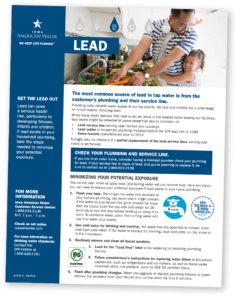For decades, the water lines and infrastructure to residential and commercial properties were made of lead and galvanized metals. With a recent announcement from the Environmental Protection Agency (EPA), requiring detailed documentation and subsequent reduction of lead and galvanized lines across the nation, the Osceola Water Works Board decided to proactively contract with V&K Engineering to begin the process of gathering data and creating a plan for the replacement of lead and galvanized lines throughout the Osceola water supply.
While new construction has required the use of copper and plastic lines, the recent announcement brings past construction and older infrastructure into the spotlight. With the research and data-gathering stage deadline set for October of 2024, the EPA is requesting documentation from all water management organizations on the use of lead and galvanized metals within existing infrastructure.
“We want to get a jump start on {the research} so we can be at the head of the line when it comes to securing financial support,” said Brandon Patterson, Osceola Water Works Superintendent.
While the research and documentation of Osceola’s water lines will come at a cost, the team at V&K with the Osceola Water Works Board will be actively pursuing available funding to meet the EPA’s request. Some of the opportunities the Board can take include moneys available through the Drinking Water State Revolving Fund (DWSRF), the Water Infrastructure Improvements for the Nation Act (WIIN) Grants, the Water Infrastructure Finance, and Innovation Act (WIFIA), and the HUD Development Community Block Grant program.
“These funds are made to help communities build sustainable infrastructure and further public health protection and objectives ,” said Patterson.
It is estimated that there are between 6 to 10 million lead service lines in the country. In 1986, the Congressional Safe Drinking Water Act – Lead Ban required “…[T]he use of “lead-free” pipe, solder, and flux in the installation or repair of any public water system or any plumbing in a residential or non-residential facility providing water for human consumption.”
Since then, the EPA has been diligent in ensuring safe drinking water through all new construction and the use of plastic lines for consumable water. This most recent announcement and research will drive the requirements for the future reduction of lead throughout the nation’s infrastructure.
“This is simply a continuation of the 1986 Safe Drinking Water Act,” said Patterson. “Making sure everyone is able to access healthy drinking water through the safest infrastructure is a priority goal for the EPA.”
More information on the EPA’s directive can be accessed through the image/link above.
The research and documentation by Osceola Water Works and V&K will continue until all customer lines have been recorded. As the data is evaluated and replacement plans are developed, the Water Works team will make sure customers are fully updated on areas of concern.


